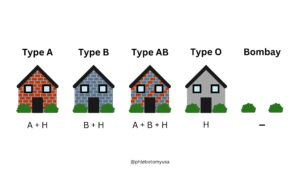11 Nov No Blood Type? Yep, It’s Possible.
Imagine going for a routine blood test and discovering that, according to standard tests, you don’t have a blood type. It sounds like science fiction, right? But for a small number of people, it’s a reality. Let us introduce the Bombay phenotype.
Named after the city it was discovered in, this is a rare condition that doesn’t fit into our usual blood typing system. Due to a unique genetic change, people with Bombay blood types don’t have the normal markers that determine blood type. Because of this, they seem to have ‘no blood type’ at all. This article will tell you everything you need to know about the Bombay blood type.
Understanding Blood Types
Before we explore the Bombay phenotype, let’s explain regular blood types. There are four types of blood: A, B, AB, and O. Blood types are determined by special proteins called antigens on red blood cells in the body. There are A antigens, B antigens, and H antigens. H antigens are unique because they create A and B antigens.
The Analogy of a House
Let’s imagine your blood type as a brick house. To make this house, you need bricks (A or B antigens) and mortar (H antigen). The H antigen acts as the mortar that binds the A or B bricks to form the structure of your house (or blood type). Type A blood is like a brick house built with A bricks and H mortar. Type B houses use B bricks and H mortar. AB houses have both A and B bricks and H mortar. O houses have no bricks and are made with only mortar. But what happens when there’s no mortar?
No Blood Type
Individuals with the Bombay blood type are missing their ‘mortar.’ This means they can’t form the ‘walls’ of A, B, AB, or O blood types. Essentially, this means that blood tests say they have no blood type.
Bombay’s Rarity and Distribution
The Bombay phenotype is extremely rare. It happens when a person gets a special gene from both their mom and their dad. Since not many people have this gene, it’s not common for a child to receive it from both parents. Because of the way genetics work, the Bombay blood type is more common in certain parts of the world:
- In India, about 1 in 10,000 people have it.
- In Europe, about 1 in 1,000,000 people have it.
- Among white people, it happens in around 1 in 250,000 people.
The Medical Dilemma
Having the Bombay blood type means that the body will not accept A, B, AB, or O blood. This creates a big risk, as Bombay blood types can only get blood from another Bombay phenotype donor. Since this blood type is so rare, there are donation programs to ensure enough of this special blood.
Conclusion
To sum up, the Bombay blood type is a rare and unique condition that shows how surprising human genetics can be. It’s a clear reminder of why blood donations are so important, especially for those with rare blood types who might need a lifesaving transfusion one day.


